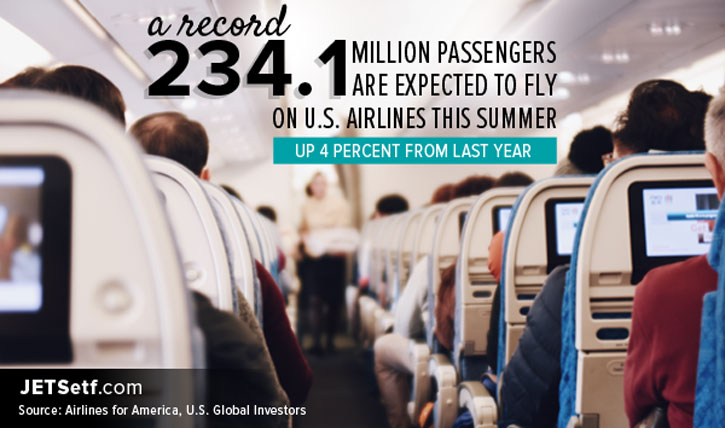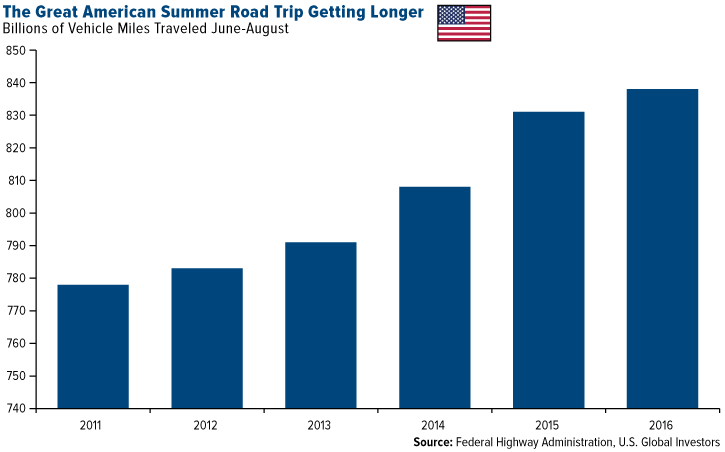The busy summer travel season is here yet again, and according to forecasts, this year could set a number of new records for airlines and highways. Thanks to a steadily improving economy, rising gross domestic product (GDP), strong consumer confidence and affordable airfare and fuel costs, more people than ever before are expected to fly on U.S. airlines and drive on the nation’s highways this summer.
Below are five reasons why this summer travel season could be a favorable one for investors.
1. Millions Leaving on a Jet Plane

Airlines for America (A4A), the main airline industry trade group, projects a record 234.1 million people flying worldwide on U.S. carriers between June 1 and August 31. That figure’s up a healthy 4 percent from last summer.
To accommodate the 2.54 million expected daily passengers—100,000 more than normal—airlines will need to add an extra 123,000 seats a day.
2. Consumer Confidence and Satisfaction Up
The surge in air travel demand is a reflection of an improving domestic economy. Consumers are happy to spend their money right now, with the Consumer Confidence Index posting a 117.9 in May. Even though this is a couple of points below the April reading, optimism still stands at a historically high level.

It doesn’t hurt that airfare is relatively affordable at the moment. According to big data firm Hopper, airfare to Europe should be a huge bargain this summer, down an expected 18 percent from last year on average.
Glowing customer satisfaction is another contributing factor to increased demand. The just-released J.D. Power 2017 North America Airline Satisfaction Study shows that passengers are more satisfied with their service than at any other time in the study’s 10-year history. Despite the regretful United Airlines incident in April, when a man was dragged from a Chicago flight bound for Louisville, overall satisfaction rose for a fifth consecutive year, reaching its highest level ever.
For the 10th straight year, Alaska Airlines was ranked first among traditional carriers. Taking the top spot among low-cost carriers was Southwest Airlines, one of our top four holdings in the U.S. Global Jets ETF (JETS).
To see a list of the top 12 highest-rated carriers, according to Embry-Riddle Aeronautical University, click here!
3. Rockin’ Down the Highway
Airline passengers won’t be the only ones enjoying an improved economy and low fuel costs this summer. More motorists than ever before are expected to make use of U.S. roads and highways, with 56 percent of Americans saying they plan on traveling more than 500 miles round trip, a 10 percent increase over last summer, according to GasBuddy. This is seen as yet another sign that domestic travel is surging.
Also pushing up expectations is what GasBuddy calls “a feat never before seen.” For the first time in recent memory, the price of gasoline at the beginning of the summer is nearly the same as it was at the beginning of the year. We normally see gas rise about 50 cents during the first five months of the year, but in 2017 it’s risen only 1.5 cents ($2.28 per gallon in January versus $2.30 in May). This should help encourage more Americans to splurge on a longer summer road trip.

4. Come and Take Me to the Airport
Passenger and freight traffic was up last year, according to Airports Council International (ACI). The group’s preliminary 2016 world airport traffic rankings report shows that total international passenger traffic in the world’s top 20 busiest airports was up 5.8 percent over the previous year. Leading the growth was Hamad International Airport in Doha, Qatar (up more than 20 percent), and Incheon International Airport in Seoul, South Korea (up more than 17 percent).
As for international air freight traffic, it grew 3.4 percent over 2015, with huge gains seen once again at Hamad International (up close to 21 percent).
According to the International Air Transport Association (IATA), global freight tonne kilometers (FTKs) grew 8.5 percent in April year-over-year, well ahead of the average pace of 3.5 percent seen over the past five years. This is good news for the airport and ground-handling service provider allocation of JETS, which includes Turkey’s TAV Airports Holdings and Singapore’s SATS.
5. Vacation Had to Get Away
These airline and highway projections become even more likely to happen when we factor in that Americans are reportedly using more of their vacation time. According to Project: Time Off, an advocacy research initiative run by the U.S. Travel Association, American workers took an average 16.8 days off in 2016, up slightly from 16.2 days the previous year. Though the difference seems marginal, the additional 0.6 days added an extra $37 billion to the U.S. economy in 2016, creating an estimated 278,000 jobs.
So whether you plan on traveling by road or air this summer, you can probably expect to be accompanied by more people than in years past. This might lead to congestion and packed airports, but ultimately we believe it’s a good opportunity for investors. Explore the U.S. Global Jets ETF (JETS) today!
Administered by the Conference Board, the Consumer Confidence Index (CCI) measures how optimistic or pessimistic consumers are with respect to the economy in the near future. The idea behind the Index is that if consumers are optimistic, they tend to purchase more goods and services. It is not possible to invest directly in an index.
The J.D. Power 2017 North America Airline Satisfaction Study measures passenger satisfaction among both business and leisure travelers, and is based on responses from 11,015 passengers who flew on a major North American airline between March 2016 and March 2017. The study was fielded between April 2016 and March 2017.
All opinions expressed and data provided are subject to change without notice. Some of these opinions may not be appropriate to every investor.
